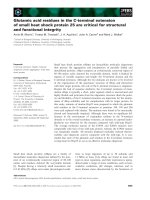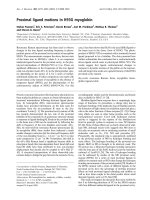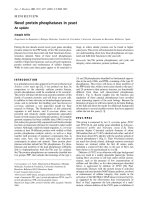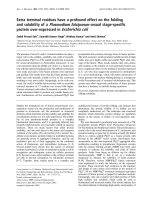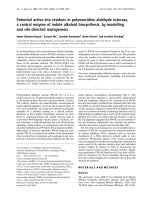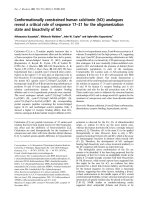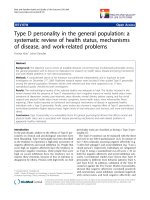Báo cáo Y học: Potential active-site residues in polyneuridine aldehyde esterase, a central enzyme of indole alkaloid biosynthesis, by modelling and site-directed mutagenesis ppt
Bạn đang xem bản rút gọn của tài liệu. Xem và tải ngay bản đầy đủ của tài liệu tại đây (295.74 KB, 8 trang )
Potential active-site residues in polyneuridine aldehyde esterase,
a central enzyme of indole alkaloid biosynthesis, by modelling
and site-directed mutagenesis
Emine Mattern-Dogru
1
, Xueyan Ma
1
, Joachim Hartmann
2
, Heinz Decker
2
and Joachim Sto¨ ckigt
1
1
Lehrstuhl fu
¨
r Pharmazeutische Biologie, Institut fu
¨
r Pharmazie, Johannes Gutenberg-Universita
¨
t Mainz, Germany,
2
Lehrstuhl fu
¨
r Molekulare Biophysik, Johannes Gutenberg-Universita
¨
t Mainz, Germany
In the biosynthesis of the antiarrhythmic alkaloid ajmaline,
polyneuridine aldehyde esterase (PNAE) catalyses a central
reaction by transforming polyneuridine aldehyde into epi-
vellosimine, which is the immediate precursor for the syn-
thesis of the ajmalane skeleton. The PNAE cDNA was
previously heterologously expressed in E. coli. Sequence
alignments indicated that PNAE has a 43% identity to a
hydroxynitrile lyase from Hevea brasiliensis,whichisa
member of the a/b hydrolase superfamily. The catalytic tri-
ad, which is typical for this family, is conserved. By site-
directed mutagenesis, the members of the catalytic triad were
identified. For further detection of the active residues, a
model of PNAE was constructed based on the X-ray crys-
tallographic structure of hydroxynitrile lyase. The potential
active site residues were selected on this model, and were
mutated in order to better understand the relationship of
PNAE with the a/b hydrolases, and as well its mechanism of
action. The results showed that PNAE is a novel member of
the a/b hydrolase enzyme superfamily.
Keywords: polyneuridine aldehyde esterase; active-site resi-
dues; site-directed mutagenesis; modelling; a/b hydrolase
enzyme superfamily.
Polyneuridine aldehyde esterase (PNAE, EC 3.1.1) is a
central enzyme in a 10-step biosynthetic pathway expressed
in the medicinal plant Rauvolfia serpentina Benth. ex Kurz.
The pathway delivers the antiarrhythmic monoterpenoid
indole alkaloid ajmaline [1,2]. From the enzymatic point of
view, this is presently one of the most detailed investigated
examples of a pathway leading to a natural product.
Reactions of this complex biosynthetic sequence are cata-
lyzed by membrane-bound and soluble enzymes such as
cytochrome P450-dependent hydroxylases, a synthase, sev-
eral reductases, a methyltransferase and a set of hydrolases
including a b-glucosidase, an acetylesterase and the herein
described methylesterase PNAE [3]. These enzymes exhibit a
high degree of substrate specificity, PNAE being the most
specific. PNAE is located in the middle of the biosynthetic
chain starting from tryptamine and secologanin and cata-
lyses the conversion of polyneuridine aldehyde into the next
stable pathway intermediate, epivellosimine (Fig. 1). The
enzyme has been detected in and partially characterized
from cell suspension cultures of R. serpentina [4,5]. PNAE
has also been highly enriched from cultured plant cells and
the cDNA was recently functionally expressed in Escherichia
coli [6]. Sequence alignment studies showed highest homol-
ogies to an esterase involved in pathogen defence in rice [7]
that hydrolyses naphthol esters, and to hydroxynitrile lyases
(HNLs) from Hevea brasiliensis [8] and Manihot esculenta
[9]. The alignment suggested that PNAE is a new member of
the a/b hydrolase superfamily that contains the putative
catalytic triad serine, aspartic acid and histidine [10].
For the present communication, a more detailed charac-
terization of PNAE was performed by testing the influence
of various inhibitors, HNL substrates and by structure
elucidation of a PNA derivative formed under in vitro
conditions. Mechanistic aspects of the reaction catalyzed
were investigated by site-directed mutagenesis, replacing the
amino acids of the putative catalytic triad and individual
cysteine residues by alanine in order to characterize the
mutant enzymes and to localize essential cysteines. Model-
ling experiments of PNAE based on the X-ray data of HNL
from H. brasiliensis [11,12] are described, allowing for the
first time a deeper insight into a particular step of Rauvolfia
alkaloid biosynthesis.
MATERIALS AND METHODS
Materials
The expression vector pQE-70 was obtained from Qiagen
(Hilden, Germany). Restriction enzymes SphIandBglII
were from New England Biolabs (Beverly, USA) and
T4-DNA ligase was from Promega (Madison, WI, USA).
Correspondence to J. Sto
¨
ckigt, Institut fu
¨
r Pharmazie,
Johannes Gutenberg-Universita
¨
t Mainz, Staudinger Weg 5,
55099 Mainz, Germany.
Fax: + 49 61313923752, Tel.: + 49 61313925751,
E-mail:
Abbreviations: AEBSF, 4-(2-aminoethyl)-benzenesulfonyl-fluoride
(trade mark name Pefabloc SC); DEPC, diethylpyrocarbonate; E-64,
N-[N-(
L
-3-trans-carboxirane-2-carbonyl)-
L
-leucyl]-agmatine; HNL,
hydroxynitrile lyase; PNAE, polyneuridine aldehyde esterase;
TPCK,
L
-chloro-3-(4-tosyl-amido)-4-phenyl-2-butanone; TLCK,
L
-chloro-3-[4-tosyl-amido]-7-amino-2-heptanone; PNA,
polyneuridine aldehyde; PMSF, phenylmethanesulfonyl fluoride.
Enzyme: hydroxynitrile lyase (EC 4.2.1.39).
(Received 14 January 2002, revised 19 April 2002,
accepted 24 April 2002)
Eur. J. Biochem. 269, 2889–2896 (2002) Ó FEBS 2002 doi:10.1046/j.1432-1033.2002.02956.x
The QuikChange
TM
in vitro Site-Directed Mutagenesis Kit
was obtained from Stratagene (La Jolla, CA, USA). For
purification of the His-tagged mutant enzymes, the nitril-
otriacetic acid/Ni
2+
resins were supplied by Qiagen (Hilden,
Germany). For the determination of molecular weight, a
Superdex 75 HR30/10 column (Amersham Pharmacia,
Freiburg, Germany) was used. For the inhibition studies,
4-(2-aminoethyl)-benzenesulfonyl-fluoride (AEBSF; trade
name Pefabloc SC) and N-[N-(
L
-3-trans-carboxirane-2-car-
bonyl)-
L
-leucyl]-agmatine (E-64) were purchased from
Roche (Mannheim, Germany),
L
-chloro-3-(4-tosyl-amido)-
4-phenyl-2-butanone (TPCK) and
L
-chloro-3-[4-tosyl-
amido]-7-amino-2-heptanone (TLCK) were purchased
from Calbiochem (La Jolla, CA, USA), phenylmethane-
sulfonyl fluoride (PMSF) was from Serva (Heidelberg,
Germany), HgCl
2
from Merck (Darmstadt, Germany) and
diethylpyrocarbonate (DEPC) was from AppliChem
(Darmstadt, Germany). All solvents and chemicals were
of analytical grade and obtained from Merck (Darmstadt,
Germany), Sigma (Deisenhofen, Germany) or from Appli-
Chem (Darmstadt, Germany).
Site-directed mutagenesis
Site-directed mutagenesis of (His)
6
PNAE was achieved
using the QuikChange
TM
in vitro Site-Directed Mutagenesis
Kit, according to the manufacturer’s recommendations. For
generation of the mutant enzymes, the following oligonu-
cleotides were used: C20A: 5¢-CTGGTACACGGCGGAT
GTCTCGGAGCTTGGATCTGG-3¢. C132A: 5¢-CCGTT
TGAGAAGTACAATGAGAAGTGTCCGGCAGATA
TG-3¢. C170A: 5¢-GGCCCTCAAAATGTTCCAGAATT
GCTCAGTCGAGGACCTTG-3¢.C-213S:5¢-CGGTGA
AGCGAGCTTATATCTTTTGCAATGAAGATAAAT
CATTT-CC-3¢. C257A: 5¢GCCAAGGGAAGTTTGCA
AGTGCCTGCTTGATATATCAGATT-CA-3¢. H17A:
5¢-GCATTTTGTTCTGGTACACGGCGGATGTCTCG
GAGCTTGG-3¢.H-86A:5¢-GGTTGTTCTTCTTGG
CCATAGCTTTGGTGGCATGAGTTTGGG-3¢. S87A:
5¢-GTTCTTCTTGGCCATAGCTTTGGTGGCATGAG
TTTGGG-3¢. H244A: 5¢-CAAAGAAGCAGATCATAT
GGGAATGCTTTCGCAGCCAAGGG-3¢. D216A: 5¢-G
CGAGCTTATATCTTTTGCAATGAAGATAAATCAT
TTCCAGTTGAG-3¢
All of the primers were 5¢-phosphorylated and of high
purity salt free grade. The substituted nucleotides are
underlined and written in bold script.
Enzyme expression and purification
For the expression of the mutated cDNAs, reading frames
were amplified with the primer pair pQE70PErev and
pQE70PEfor, which included the appropriate restriction
sites (SphIandBglII) to enable the ligation into the
expression vector pQE70. After ligation, the mutants were
transformed into E. coli strain TOP 10, and were grown at
room temperature for 64 h without shaking, in Luria–
Bertani medium containing 100 lgÆmL
)1
ampicillin. From
these cultures, crude extracts were prepared by sonification
at 4 °C with a Sonoplus Homogenisator HD 70 with
sonotrode MS 73 and (Sonifier) HF-Generator GM 70
(70 W, 20 kHz) (Bachofer GmbH, Reutlingen, Germany)
(6 · 10 s). Activities of the mutated enzymes with substrate
were monitored by a standard HPLC assay as recently
described [6]. The plasmids were purified by nucleospin mini
preparation (Macherey–Nagel, Du
¨
ren, Germany), and
sequenced by primer walking using the dideoxy chain
termination method [13].
For protein purification, the mutated and the wild-type
cDNAs were transformed into the E. coli strain
M15[pREP4]. An inoculum of 50 mL was grown at 25 °C
for 40 h in the above mentioned medium containing also
kanamycin (25 lgÆmL
)1
), and was diluted 1 : 9 with the
same medium. After growing for 1 h with shaking
(100 r.p.m), isopropyl thio-b-
D
-galactoside was added
(1 m
M
final concentration). After further cultivation at
25 °C until a D
600
¼ 1.0–1.1 was reached, the cells were
harvested by centrifugation (10 000 g,4°C). The pellet was
re-suspended in 5 mL re-suspension buffer (50 m
M
NaH
2
PO
4
,300m
M
NaCl, pH 7.0) containing 10 m
M
imidazole and was sonicated at 4 °C(6· 10 s). After
centrifugation (10 000 g, 20 min) total PNAE activity was
determined in the supernatant. (His)
6
PNAE wild-type
protein and the muteins were purified on self packed Ni
2+
resin columns (0.7 cm internal diameter · 1cm).For the
washing steps, the above mentioned buffer containing 20
and 50 m
M
imidazole, each of 20 mL was used and elution
was performed with 250 m
M
imidazole. The purity of the
eluted fractions was checked by SDS/PAGE. The fractions
with the highest protein concentration were combined and
dialysed against 50 m
M
Na phosphate buffer, pH 7.0,
containing 20 m
M
2-mercapoethanol for 20 h at 4 °C. After
determination of the enzyme activity with the standard
enzyme assay, the kinetic studies (K
m
, k
cat
) were completed
for the active muteins and for the wild-type enzyme.
Enzyme and protein assays
Protein concentrations of the muteins and the wild-type
enzyme were determined with the Bradford reagent [14]
using BSA (SERVA, Heidelberg, Germany) as standard.
Fig. 1. The major steps of the ajmaline pathway. The biosynthesis of
the antiarrhythmic alkaloid ajmaline, in Rauvolfia serpentina cell sus-
pension cultures, involves the conversion of polyneuridine aldehyde
into epi-vellosimine. This central reaction of the pathway is catalysed
by the enzyme polyneuridine aldehyde esterase (PNAE).
2890 E. Mattern-Dogru et al. (Eur. J. Biochem. 269) Ó FEBS 2002
The enzyme activity in the pure fractions was assayed as
follows: the incubation mixture with a total volume of
50 lL contained a final concentration of 0.01 m
M
poly-
neuridine aldehyde (PNA) and 0.1
M
sodium phosphate
buffer (pH 7.0) with various enzyme concentrations. The
mixture was incubated for 15 min at 30 °C. After the
addition of 2 lLHCl(0.1
M
), 5 lLNaBH
4
solution (1% in
10 m
M
NaOH) and 0.1 mL MeOH, the mixture was
centrifuged (18 000 g, 5 min) and the supernatant was
analysed by the standard HPLC assay [6].
Assay for the production of the polyneuridine aldehyde
ethylester derivative
The incubation mixture with a total volume of 10 mL was
divided into 10 · 1 mL aliquots. For the most efficient
synthesis of the ethylester derivative, 0.1 m
M
of PNA was
incubatedin50m
M
sodium phosphate buffer (pH 8.0) in
the presence of 15% EtOH, with various enzyme concen-
trations for 20 min at 30 °C. The conversion was tested by
the standard HPLC method. The reaction products were
extracted from the incubation mixture twice with 200 lL
CHCl
3
and purified by preparative thin layer chromato-
graphy with the following solvent system; CHCl
3
/MeOH/
25% NH
3
(9 : 1 : 0.02). The products were identified by
EI-mass spectrometry on a Finnigan MAT 44S quadrupole
instrument (Bremen, Germany) by direct inlet and 70 eV.
Molecular mass determination
For the determination of the relative molecular mass,
100 lLof(His)
6
PNAE wild-type protein, obtained from
E. coli M15 cells (0.68 mgÆmL
)1
) was loaded onto a
superdex column and fractionated (each 0.5 mL) with a
50 m
M
Na phosphate buffer pH 7.0 containing NaCl
(150 m
M
). For comparison, the same procedure was
repeated with 100 lL of the crude extract preparation of
theenzyme(2.0mgÆmL
)1
)fromRauvolfia plant cell
suspension culture.
Inhibition studies
The effects of the following inhibitors, in the mentioned
concentrations, were checked on the pure (His)
6
PNAE
enzyme fractions that were dialysed against 50 m
M
sodium
phosphate buffer before use (pH 7.0, for 20 h at 4 °C):
AEBSF (1.0 m
M
,4.0m
M
), phenylmethanesulfonyl fluoride
(1.0 m
M
), TPCK (200 l
M
), TLCK (120 l
M
), E-64 (25 l
M
),
HgCl
2
(200 l
M
), DEPC (0.8–1.2 m
M
). The enzyme frac-
tions, except DEPC, were preincubated with inhibitor for
1hat30°C. With DEPC, the enzyme was preincubated at
4 °C for 30 min. Then the activity of the enzyme was tested.
Model-building
A model of the three-dimensional structure of (His)
6
PNAE
was constructed using a homology-modelling approach
based on the precalculated alignment of the hydroxynitrile
lyase to which PNAE has 43% identity. The X-ray structure
of hydroxynitrile lyase from H. brasiliensis was used as a
template structure [11]. (Protein Data Bank accession no.
1YAS). The model structures were calculated using the
software
MODELLER
(version 4) [15], a program that models
structures by satisfaction of spatial restraints. Fifteen
models were created for wild-type PNAE. The
CCP
4
program suite [16] was used for the superposition of the
models and calculations.
RESULTS
Sequence analysis of recently expressed (His)
6
PNAE in
E. coli placed this specific enzyme of ajmaline biosynthesis,
as a new member, into the a/b hydrolase enzyme super-
family. Most typical for this class of hydrolases are the three
strictly conserved amino acids Ser, Asp, and His, which
could represent the catalytic triad of PNAE [6]. Moreover,
re-activation of an enzyme preparation by 2-mercapoetha-
nol suggested free SH-groups to be necessary for hydrolytic
activity of PNAE. In order to gain evidence for these
suggestions, inhibitor studies, site-directed mutagenesis
experiments and modelling of PNAE were performed.
Inhibitor studies
Several known inhibitors reacting with the amino acids Ser,
Cys or His were tested on wild-type (His)
6
PNAE (Table 1).
Pefabloc SC (AEBSF), a selective serine modifying agent
[17], did not influence the enzyme activity at a variety of
concentrations, which was also observed for the Cys
selective inhibitor E-64 [18]. Partial inhibition of 20 and
12% of PNAE was measured with the Ser-Cys inhibitors
phenylmethanesulfonyl fluoride and TLCK, respectively.
TPCK had, however, no effect on catalytic activity.
Incubation of purified (His)
6
PNAE wild-type enzyme in
the presence of Hg
+2
resulted in complete loss of catalytic
activity, which was recovered (90%) after adding 60 m
M
2-
mercapoethanol. Complete inhibition occurred with DEPC,
which is a strong histidine-modifying agent [19].
Extraordinarily high concentrations of 2-mercapoethanol
(upto2
M
) did not reduce the activity of (His)
6
PNAE.
Site-directed mutagenesis
In this study, we have produced wild-type (His)
6
PNAE and
10 muteins of it. Four of six cysteine residues in positions 20,
132, 170 and 257 were changed to alanine and one (position
213) to serine. Histidine at position 17, 86 and 244, serine at
87 and aspartic acid at 216 were replaced by alanine.
Among these, Ser87, Asp216 and His244 formed
the putative catalytic triad of PNAE, analogous to
H. brasiliensis HNL and most other a/b hydrolase enzyme
superfamily members [10].
Table 1. Inhibition studies with pure (His)
6
PNAE. The experiments
were performed with SH-group modifiers, selective serine-, cysteine-
and histidine-inhibitors and serine-cysteine modifying agents.
Inhibitor (m
M
) Modified residue Inhibition (%)
HgCl
2
(0.2) Cysteine 100
E-64 (0.025) Cysteine 0
AEBSF (1.0, 4.0) Serine 0
PMSF (1.0) Serine-Cysteine 20
TLCK (0.12) Serine-Cysteine 12
TPCK (0.2) Serine-Cysteine 0
DEPC (0.8–1.2) Histidine 100
Ó FEBS 2002 Potential active-site residues of PNA esterase (Eur. J. Biochem. 269) 2891
Expression of (His)
6
PNAE muteins in E. coli
These muteins were expressed in E. coli M15 using the
bacterial expression vector pQE-70. Purification of the wild-
type enzyme and the individual muteins was facilitated by
introduction of a His-tag at the N-terminus followed by
step-gradient elution with imidazole from Ni
2+
-nitrilotri-
acetic acid columns. Except for the inactive muteins, all the
active enzyme preparations showed a purity of > 95%,
based on SDS/PAGE and Coomassie-blue staining (Fig. 2).
The degree of enzyme purity among the active muteins and
the wild-type preparations was comparable.
Enzyme activity and kinetics
The enzyme activity tests using PNA as substrate were
performed with the wild-type enzyme and its individual
muteins after purification. The site-directed mutagenesis
results verified that the strictly conserved amino acids
identified by multiple sequence alignment [6], namely Ser87,
Asp216 and His244, formed the catalytic triad of (His)
6
PNAE. After they were individually replaced by alanine, the
activity of the enzyme was lost completely (Table 2). With
the Cys muteins, the results were variable. After mutating
Cys213 and 257, the specific activity of the enzyme was not
considerably affected, even though the mutant enzyme
C213S contained a second mutation that occurred fortuit-
ously during PCR. The glycine at position 152 was
exchanged for glutamic acid, which seemed not to have
further influence on activity. Nevertheless, the specific
activities of each of the muteins decreased. With the
exchange of Cys132, there was a dramatic decrease (four-
fold) in the specific activity, and in the case of Cys170, the
decrease in the specific activity was even greater (approx.
sevenfold). The exchange of Cys20 resulted in the total
inactivation of the mutant enzyme. For the remaining two
histidines, the results were also remarkable. When His17
was changed to Ala, the specific activity significantly
decreased, but still the kinetic data could be determined.
But in the case of His86, the activity was so low that it was
not possible to perform further kinetic experiments. The
specific activity could, however, be measured (Table 2).
The kinetic parameters, such as K
m
,andk
cat
, for the wild-
type and the muteins are given in Table 2, together with the
specific enzyme activities ranging from 32 to 24 pkatÆmg
)1
for active preparations. The K
m
value of the wild-type
enzyme is smaller than previously reported [6]. For muteins
with low activity, up to 300-fold higher amounts of
enzyme and prolongation of incubation periods from
10 min to 3 h were used, which were sufficient to determine
relative activities equivalent to 0.1% compared to the wild-
type PNAE.
Substrate specificity experiments with racemic
mandelonitrile
The activity of wild-type (His)
6
PNAE was tested on racemic
mandelonitrile, which is the natural substrate for the FAD
dependent HNL from Prunus sp. (Rosaceae) [9] but
accepted as well by H. brasiliensis HNL. The specific
activity was measured by following the formation of
Fig. 2. Gradient-step purification of (His)
6
PNAE and its muteins. The
soluble protein extracts were in each case purified by step gradient
elution with imidazole on Ni
2+
-nitrilotriacetic acid columns. The
fractions were checked by SDS/PAGE and Coomassie-blue staining.
The position of the purified proteins is marked with an arrow. The
labelling of the lanes is as follows: (A) Marker protein, (B) crude E. coli
extract, (C) pure wild-type (His)
6
PNAE, (D) H17A, (E) C20A,
(F) H86A, (G) C132A, (H) C170A, (I) C213S, (J) C257A, (K) S87A,
(L) H244A, (M) D216A.
Table 2. Comparison of kinetic parameters of (His)
6
PNAE and its muteins expressed in E. coli. K
m
and k
cat
values were calculated from Lineweaver–
Burk plots using PNA as substrate. Values of linear regression coefficients were >0.9 in all experiments. ND, not detectable.
Enzyme
K
m
(l
M
)
Specific activity
(nkatÆmg protein
)1
)
k
cat
(nkatÆmg protein
)1
)
Protein conc. in
incubation (lgÆmL
)1
)
Wild-type 36 32.4 146.7 0.3
C257A 46 21.5 122.5 0.48
C213S/G152Q 33 22.5 98.56 0.46
C170A 34.5 4.9 20.58 0.9
C132A 108 8.1 73.0 1.26
C20A ND ND ND 6.2
H17A 273 0.2 5.75 12.0
H86A ND 0.024 ND 10.8
S87A* ND ND ND 98.4
D216A* ND ND ND 14.4
H244A* ND ND ND 62.4
2892 E. Mattern-Dogru et al. (Eur. J. Biochem. 269) Ó FEBS 2002
benzaldehyde (detection limit 0.5%) as described in the
mandelonitrile assay for HbHNL [20]. But as expected, the
highly substrate-specific PNAE did not accept the substrate
of H. brasiliensis HNL, as in the case of earlier substrate
specificity experiments with various methylesters [6].
Identification of a new intermediate of the PNAE
reaction and first recognition of a novel substrate
When the enzyme assay was performed in the presence of
ethanol, a novel intermediate was detected by HPLC
analysis showing a retention time of 7.3 min. This com-
pound, which is the ethyl ester derivative of PNA, is
accepted by the enzyme as shown by its conversion into
vellosimine after prolonged incubation or when excessive
amount of PNAE is added (data not shown). This is the
only known compound that is accepted by the enzyme in
addition to its natural substrate PNA. After optimization of
assay conditions for its formation, the product was isolated
and analysed by MS. EI-MS data were m/z (%): 366 (37,
M
+
), 365 (37, M
+
-1), 335 (17, M
+
-CH
2
OH), 249 [71,
365-C(CH
2
OH)CO
2
CH
2
CH
3
], 235 (15), 182 (24), 168 (100),
156 (21), 143(12), 129 (15), 115 (21).
Molecular mass determination
PNAE was found to migrate on SDS/PAGE with a
mobility corresponding to an apparent molecular mass of
30 000 Da [6]. After gel filtration of the recombinant and
the native enzyme through a Superdex column, a relative
molecular mass of 60 000 Da was determined, suggesting
that the enzyme is a homodimer in aqueous solutions at
pH 7.0. The dimer had not been observed earlier with an
enriched PNAE preparation chromatographed on an AcA
54 column [4,5].
Modelling
Based on the three-dimensional structure of HNL from
H. brasiliensis, which is known from an X-ray analysis with
2.3 A
˚
resolution [11], a model of (His)
6
PNAE was con-
structed. For this purpose, 15 different models were
generated by the modeller program. The deviations between
these models were generally small for the backbone atoms
(rmsd from 0.2 to 0.6 A
˚
). The model with the best
stereochemistry was selected for the wild-type structure.
All the measurements given in the text represent the C
a
–C
a
distances.
DISCUSSION
Indole alkaloid biosynthesis of the ajmaline/sarpagine
group which occurs in the genus Rauvolfia, has been well-
elucidated during the last decade. For a more detailed
determination of enzyme properties and structures and for
knowledge of the catalytic mechanisms, heterologous
expression of the appropriate cDNAs is a prerequisite.
Sequence alignments of PNAE with the other enzymes of
the a/b hydrolase family showed identity up to 43% with
HNL from H. brasiliensis. This can be considered as high in
this particular enzyme family, suggesting that the two
enzymes are closely related to each other [10,21]. Gel
filtration showed that at neutral pH, PNAE forms a
homodimer, as do HbHNL and acetylcholine esterase [22].
Due to recovery of enzyme activity with 2-mercapoethanol
after HgCl
2
inhibition, a probable formation of an S–S
bridge resulting in homo-dimerization was taken into
consideration. However, high amounts of 2-mercapoetha-
nol, which would lead to the dissociation of such a dimer
into both subunits [23], did not affect the activity of PNAE.
The dimerization obviously does not depend on cysteine
residues, but most probably takes place via a contact area of
apolar residues [12], as the sequence comparison between
the HbHNL and PNAE gives a pronounced homology of
75% (Fig. 3) at these apolar sections. Also, as the dimeric
nature was observed both for the native enzyme and the
recombinant (His)
6
- PNAE, the His-tag has no apparent
influence on dimer formation.
In contrast, from the point of view of substrate accept-
ance, there are no similarities between the enzymes. Whereas
Fig. 3. Sequence alignment of PNAE and H. brasiliensis HNL. The gray shading indicates the sequence identity (43%) between the two enzymes.
The yellow regions are the apolar sections which may be responsible for the dimerisation of PNAE. For HbHNL these regions are dark gray with
white letters. There is a sequence similarity of 82% between the two apolar sections. The residues marked red with a star above form the catalytic
triad. The mutations which reduce the activity are shown in blue and the mutations leading to complete loss of enzyme activity are marked in green.
Ó FEBS 2002 Potential active-site residues of PNA esterase (Eur. J. Biochem. 269) 2893
HNLs have a rather broad substrate specificity, PNAE will
only accept its natural substrate and the ethyl analogue.
When the assays of PNAE were performed in presence of
ethanol in order to dissolve PNA, a second conversion
product was observed by HPLC. The addition of more
enzyme to these incubations resulted in conversion of this
compound to vellosimine. The structure determination of
this intermediate by mass spectrometry proved the forma-
tion of an ethyl ester, a PNA analogue, which is the only
other substrate so far known to be accepted by the enzyme.
The formation of this analogue, which is most probably
formed by trans-esterification of the substrate, was previ-
ously detected also for the enriched enzyme fractions from
the plant cells. It can be speculated that an enzyme-bound,
activated intermediate of the substrate, such as PNA acid
bound as a thioester to a cysteine SH-group, might be
involved in the mechanism. However, replacement of
several cysteine residues of PNAE (see data below) by
alanine did not influence the formation of the analogue.
The mechanism of this process therefore remains to be
elucidated.
The results of the inhibition studies were also helpful to
define potential active residues. The complete inhibition of
the enzyme with HgCl
2
showed the importance of cysteine
residues for the activity. However, at this stage it still
remained unclear whether PNAE is a cysteine or serine
hydrolase, regarding studies with cysteine and serine
protease inhibitors. The next clear information obtained
was the necessity of histidine groups which proved the active
role of at least one histidine in substrate binding. The
following site-directed mutation experiments were therefore
designed to prove whether PNAE is indeed a member of the
a/b hydrolase fold enzyme family, as we have suggested
recently [6]. If so, PNAE must harbour the catalytic triad
nucleophile-histidine-acid. Based on sequence alignment,
Ser87 is a member of the consensus sequence Gly-X-Ser-X-
Gly/Ala in PNAE, which defines this residue in serine
hydrolases. It is most probable that PNAE can be classified
among this group. Replacement of Ser87 by alanine formed
a mutein that was unable to hydrolyse PNA even when 330-
fold excess of enzyme was used compared to the wild-type.
This result indicates an absolute involvement of Ser87 in the
catalytic process. Exchange of His244 gave a mutein that
was completely inactive in the PNA hydrolysing assay, even
if a 200-fold excess of enzyme was used. This shows
unequivocally that His244 belongs to the catalytic triad.
Exchange of the last putative member of the catalytic triad,
which from alignment studies is aspartic acid at position
216, also gave a mutein devoid of any PNA-hydrolytic
activity. Even a 50-fold excess of this mutein gave no
Fig. 4. Stereo pictures of the modelled structure of (His)
6
PNAE. Only the backbone and the side-chains of the mutated amino acids are shown. The
amino acids of the catalytic triad, mutations which reduced the activity of (His)
6
PNAE and mutations with a complete loss of activity are drawn in
red, blue and green, respectively. The direction of view is along the channel connecting the active site with the outside of the protein. (B) shows the
view of (A) when rotated along the y axis by 90°.The pictures were generated using the programs
MOLSCRIPT
[24] and
RASTER
3
D
[25].
2894 E. Mattern-Dogru et al. (Eur. J. Biochem. 269) Ó FEBS 2002
measurable conversion of PNA. The position of this
particular aspartic acid in the sequence and in the model,
is consistent with the complete inactivation of the mutant
enzyme. This suggests that Asp216 does indeed represent
the acidic residue in the active centre of PNAE. All these
kinetic results and theoretical data given by sequence
alignments support the assumption illustrated by the model
(Fig. 4) that in PNAE, the typical catalytic triad of the a/b
hydrolase family is conserved. The model also suggests that
the active site is deeply buried inside the protein and is
connected to the protein surface by a narrow channel (not
illustrated). The mutation of two residues Cys20 and
Cys132, which are located at the entrance of this narrow
channel, gave interesting results. The complete loss of
activity in the case of Cys20, which has a deeper location
than Cys132, suggests its extraordinary function for cata-
lysis. This may be related to its direct contribution via a free
SH-group directed into the channel. Cys132 seems to also
play an important role. When it was exchanged, a loss of
75% in specific activity was observed but more interestingly
the K
m
value increased to threefold of that of the wild-type
enzyme. This might indicate that the intake of the substrate
is hampered supporting the location of Cys132 discussed
above.
To identify histidine residues in PNAE responsible for
catalysis, His17 and His86 were replaced by alanine. In the
case of His17, which is a very conserved residue in a/b
hydrolases, there was a 162-fold decrease in the specific
activity even though the imidazole ring seems to point
outward, in the opposite direction of the active centre
(Fig. 4). The eightfold increase in the K
m
value (Table 2)
compared to wild-type may demonstrate a strong influence
of this residue on maintaining the conformation in addition
to its probable contribution to the hydrolysis mechanism.
His86, which is a direct neighbour of the catalytic Ser87
(3.8 A
˚
), with an imidazole ring directed towards the active
centre, showed a 1600-fold decrease in specific activity. This
suggests a strong change at least in the steric properties of
the substrate binding site. However, it remains unclear as to
how these histidines finally influence PNA hydrolysis.
Another amino acid interesting for PNAE activity is
cysteine. Therefore, additional cysteine mutation studies
were carried at positions 213, 257 and 170. C213S and
C257A showed almost 33% loss in their specific activities;
for C170A this decreased to 85%. The models (Fig. 4) show
how closely Cys213 is located to Asp216 (5.8 A
˚
), whereas
Cys257 is located further away (17.9 A
˚
). Interestingly, the
inhibition of the enzyme in both cases is almost identical.
Cys170 is also located behind the catalytic triad member
His244 at a distance of 9.3 A
˚
, but nevertheless exhibiting a
great loss in the specific activity. The influence of these
residues on the activity by modelling at this stage is not
clear. On the other hand, the K
m
values for the three muteins
are almost identical to that of the wild-type, indicating that
these cysteines might not have a big influence on the binding
of the substrate.
In conclusion, we have identified by site-directed muta-
genesis the residues of the catalytic triad Ser87, Asp216 and
His244 of PNAE. The order of these catalytic amino acids
corresponds to that of the a/b hydrolase family, which
suggests that PNAE is indeed a novel member of this group.
The locations of the mutated residues in the model and the
kinetic results support the notion that the enzyme has a very
similar topology to HbHNL. However, to gain more insight
into the mechanism of hydrolysis and the conformation of
PNAE, it would be necessary to perform X-ray diffraction
analysis.
ACKNOWLEDGEMENTS
This work was supported by a grant of Deutsche Forschungsgeme-
inschaft (Bonn, Bad-Godesberg, Germany), the Fonds der Chemischen
Industrie (Frankfurt/Main, Germany) and by BMBF (Bonn,
Germany). Dr Xueyan Ma acknowledges BASF (Ludwigshafen,
Germany) for a scholarship.
REFERENCES
1. Sto
¨
ckigt, J. (1995) Biosynthesis in Rauvolfia serpentina,modern
aspects of an old medicinal plant. In The Alkaloids (Cordell, G.A.,
ed.), Vol. 47, pp. 115–172. Academic Press, San Diego, CA, USA.
2. Kleinsorge, H. (1959) Klinische Untersuchungen u
¨
ber die
Wirkungsweise des Rauwolfia Alkaloids (Ajmalin) bei Herzrhy-
thmussto
¨
rungen insbesondere der Extrasystole. Med. Klin.
54, 409–416.
3. Sto
¨
ckigt, J. (1998) Alkaloid metabolism in plant cell culture. In
Natural Product Analysis (Schreier, P., Herderich, M. & Humpf,
H M., eds), pp. 313–325. Vieweg, Braunschweig, Wiesbaden,
Germany.
4. Pfitzner, A. & Sto
¨
ckigt, J. (1983) Polyneuridine aldehyde esterase:
an unusually specific enzyme involved in the biosynthesis of sar-
pagine type alkaloids. J. Chem. Soc. Chem. Commun. 459–460.
5. Pfitzner, A. & Sto
¨
ckigt, J. (1983) Characterization of poly-
neuridine aldehyde esterase, a key enzyme in the biosynthesis of
sarpagine/ajmaline type alkaloids. Planta Med. 48, 221–227.
6. Dogru, E., Warzecha, H., Seibel, F., Haebel, S., Lottspeich, F. &
Sto
¨
ckigt, J. (2000) The gene encoding polyneuridine aldehyde
esterase of monoterpenoid indole alkaloid biosynthesis in plants is
an ortholog of the a/b hydrolase super family. Eur. J. Biochem.
267, 1397–1406.
7. Wa
¨
spi, U., Misteli, B., Hasslacher, M., Jandrositz, A., Kohlwein,
S.D., Schwab, H. &Dudler, R. (1998) The defense-related rice gene
Pir7b encodes an a/b hydrolase fold protein exhibiting esterase
activity towards naphthol AS-esters. Eur. J. Biochem. 254, 32–37.
8. Hasslacher, M., Schall, M., Hayn, M., Griengl, H., Kohlwein,
S.D. & Schwab, H. (1996) Molecular cloning of the full-length
cDNA of (S)-hydroxynitrile lyase from Hevea brasiliensis. J. Biol.
Chem. 271, 5884–5891.
9. Hughes, J., de Carvalho, F.J.P.C. & Hughes, M.A. (1994) Puri-
fication, characterization, and cloning of a-hydroxynitrile lyase
from cassava (Manihot esculenta Crantz). Arch. Biochem. Biophys.
311, 496–502.
10. Ollis, D.L., Cheah, E., Cygler, M., Dijkstra, B., Frolow, F.,
Franken, S.M., Harel, M., Remington, S.J., Silman, I., Schrag, J.,
Sussman, J.L., Verschueren, K.H.G. & Goldman, A. (1992) The
a/b hydrolase fold. Protein Eng. 5, 197–211.
11. Gruber, K., Gugganig, M., Wagner, U.G. & Kratky, C. (1999)
Atomic resolution crystal structure of hydroxynitrile lyase from
Hevea brasiliensis. Biol. Chem. 380, 993–1000.
12. Wagner, U.G., Hasslacher, M., Griengl, H., Schwab, H. & Kratky,
C. (1996) Mechanism of cyanogenesis: the crystal structure of
hydroxynitrile lyase from Hevea brasiliensis. Structure 4, 811–822.
13. Sanger, F., Nicklen, S. & Coulson, A.R. (1977) DNA Sequencing
with chain-terminating inhibitors. Proc. Natl Acad. Sci. USA 74,
5463–5467.
14. Bradford, M. (1976) A rapid and sensitive method for the quan-
titation of microgram quantities of protein utilizing the principle
of protein-dye binding. Anal. Biochem. 72, 248–254.
15. Sali, A. & Blundell, T. (1993) Comparative protein modelling by
satisfaction of spatial restraints. J. Mol. Biol. 234, 779–815.
Ó FEBS 2002 Potential active-site residues of PNA esterase (Eur. J. Biochem. 269) 2895
16. Collaborative Computational Project Number, 4 (1994) The
CCP4 suite: programs for protein crystallography. Acta Cryst.
D50, 760–763.
17. Mintz, G.R. (1993) Technical note: an irreversible serine protease
inhibitor. Biopharm. 6, 34–38.
18. Umezawa, H. & Aoyagi, T. (1983) In Protease Inhibitors: Medical
and Biological Aspects. (Katunuma, N., ed.), pp. 3–15. Springer
Verlag, Berlin.
19. Miles, E.W. (1977) Modification of histidyl residues in proteins by
diethylpyro-carbonate. Methods Enzymol. 47, 431–442.
20. Hanefeld, U., Straathof, A.J.J. & Heijnen, J.J. (1999) Study of the
(S)-hydroxynitrile lyase from Hevea brasiliensis: mechanistic
implications. Biochim. Biophy. Acta. 1432, 185–193.
21. Heikinheimo, P., Goldman, A., Jeffries, C. & Ollis, D.L. (1999) Of
barn owls and bankers: a lush variety of a/b hydrolases. Structure
7, R141–R146.
22. Sussman, J.L. & Silman, I. (1991) Atomic structure of acetyl-
cholinesterase from Torpedo californica: a prototypic acetyl-
choline-binding protein. Science 253, 872–879.
23. Esen, A. (1992) Purification and partial characterisation of maize
(Zea mays L.) b-glucosidase. Plant Physiol. 98, 174–182.
24. Esnouf, R.M. (1999) Further additions to Molscript version 1.4.
including reading and contouring of electron-density maps. Acta
Cryst. D55, 938–940.
25. Merritt, E.A. & Bacon, D.J. (1997) Raster3D – photorealistic
molecular graphics. Methods Enzymol. 277, 505–524.
2896 E. Mattern-Dogru et al. (Eur. J. Biochem. 269) Ó FEBS 2002

